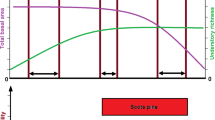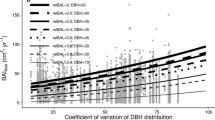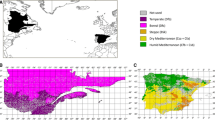Abstract
Recent experimental advances on the positive effect of species richness on ecosystem productivity highlight the need to explore this relationship in communities other than grasslands and using non-synthetic experiments. We investigated whether wood production in forests dominated by Aleppo pine (Pinus halepensis) and Pyrenean Scots pine (Pinus sylvestris) differed between monospecific and mixed forests (2–5 species) using the Ecological and Forest Inventory of Catalonia (IEFC) database which contains biotic and environmental characteristics for 10,644 field plots distributed within a 31,944 km2 area in Catalonia (NE Spain). We found that in Pyrenean Scots pine forests wood production was not significantly different between monospecific and mixed plots. In contrast, in Aleppo pine forests wood production was greater in mixed plots than in monospecific plots. However, when climate, bedrock types, radiation and successional stage per plot were included in the analysis, species richness was no longer a significant factor. Aleppo pine forests had the highest productivity in plots located in humid climates and on marls and sandstone bedrocks. Climate did not influence wood production in Pyrenean Scots pine forests, but it was highest on sandstone and consolidated alluvial materials. For both pine forests wood production was negatively correlated with successional stage. Radiation did not influence wood production. Our analysis emphasizes the influence of macroenvironmental factors and temporal variation on tree productivity at the regional scale. Well-conducted forest surveys are an excellent source of data to test for the association between diversity and productivity driven by large-scale environmental factors.


Similar content being viewed by others
References
Anonymous (1992) JMP 2.0.5. SAS Institute, Belmont, Calif.
Assmann E (1970). The principles of forest yield study. Pergamon, Oxford
Barbéro M, Loisel R, Quézel P, Richardson DM, Romane F (1998) Pines in the Mediterranean Basin. In: Richardson DM (ed) Ecology and biogeography of Pinus. Cambridge University Press, Cambridge, pp 153–170
Bengtsson J, Engelhart K, Giller P, Hobbie S, Lawrence D, Levine J, Vilà M, Weiner J, Wolters V. (2002) Slippin' and slidin' between the scales: the scaling components of biodiversity-ecosystem functioning relations. In: Loreau MS, Naem S, Inchausti P (eds) Biodiversity and ecosystem functioning: synthesis and perspectives. Oxford University Press, Oxford, pp 209–220
Caspersen JP, Pacala SW (2001) Successional diversity and forest ecosystem function. Ecol Res 16:895–903
Chaves MM, Rodrigues ML (1987) Photosynthesis and water relations of grapevines growing in Portugal- response to environmental factors. In: Tenhunen JD, Catarino FM, Lange OL, Oechel WC (eds) Plant response to stress. Springer, Berlin Heidelberg New York, pp 379–390
García LV, Marañon T, Moreno A, Clemente L (1993) Above-ground biomass and species richness in a Mediterranean salt marsh. J Veg Sci 4:417–424
Gentry AH (1982) Patterns of neotropical plant species diversity. Evol Biol 5:1–84
Gracia C, Burriel JA, Ibáñez JJ, Mata T, Vayreda J (2000–2002) Inventari ecològic i forestal de Catalunya. CREAF, Bellaterra (http://www.creaf.uab.es/iefc)
Hector A, Schmid B, Beierkuhnlein C. et al. (1999). Plant diversity and productivity experiments in European grasslands. Science 286:1123–1127
Huston M (1980). Soil nutrients and tree richness in Costa Rican forests. J Biogeogr 7:147–157
Huston MA (1997) Hidden treatments in ecological experiments: re-evaluating the ecosystem function of biodiversity. Oecologia 110:449–460
Kaiser J (2000) Rift over biodiversity divides ecologists. Science 289:1282–1283
Kawahara T, Yamamoto K (1986) Studies of mixed stands of akamatzu (Pinus densiflora) and hinoki (Chamaecyparis obtusa). I. Production and decomposition of organic matters. Jpn For Soc 64:331–339
Kelty MJ (1992) Comparative productivity of monocultures and mixed-species stands. In: Kelty MJ, Larson BC, Oliver CD (eds) The ecology and silviculture of mixed-species forests. Kluwer Academic, Dordrecht, pp 153–170
Kerr G, Nixon CJ, Matthews RW (1992) Silviculture and yield of mixed-species stands: the UK experience. In: Cannell MGR, Malcolm DC, Robertson PA (eds) The ecology of mixed-species stands of trees. Blackwell, London, pp 35–52
Loreau M (1998) Separating sampling and other effects in biodiversity experiments. Oikos 82:600–602
Loreau M, Naeem S, Inchausti P, Bengtsson J, Grime JP, Hector A, Hooper DU, Huston MA, Raffaelli D, Schmid B, Tilman D, Wardle DA (2001) Biodiversity and ecosystem functioning: current knowledge and future challenges. Science 294:804–808
Lugo AE (1992) Comparison of tropical tree plantations with secondary forests of similar age. Ecol Monogr 62:1–41
Mittelbach GG, Steiner CF, Scheiner SM, Gross KL, Reynolds HL, Waide RB, Willig MR, Dodson SI, Gough L (2001) What is the observed relationship between species richness and productivity? Ecology 82:2381–2396
Ojeda F, Marañon T, Arroyo J (1996) Patterns of ecological, chorological and taxonomic diversity at both sides of the Strait of Gibraltar. J Veg Sci 7:63–72
Pausas JG (1994) Species richness patterns in the understorey of Pyrenean Pinus sylvestris forest. J Veg Sci 5:517–524
Pausas JG, Carreras J (1995) The effect of bedrock type, temperature and moisture on species richness of Pyrenean Scots pine (Pinus sylvestris L.) forests. Vegetatio 116:85–92
Pausas JG, Carreras J (1999) Relationship between vegetation units and terrain parameters in vegetation maps using GIS tools: a case study in the eastern Pyrenees. Ecol Mediterr 25:57–73
Polero Z (1981) Development of mixed forest stands. Prace VULHM 59:179–202
Rey-Benayas JM, Scheiner SM (1993) Diversity patterns of wet meadows along geochemical gradients in central Spain. J Veg Sci 4:103–108
Richardson DM, Rundel PW (1998) Ecology and biogeography of Pinus: an introduction. In: Richardson DM (ed) Ecology and biogeography of Pinus. Cambridge University Press, Cambridge, pp 3–48
Rouget M, Richardson DM, Lavorel S, Vayreda J, Gracia C, Milton SJ (2001) Determinants of distribution of six Pinus species in Catalonia, Spain. J Veg Sci 12:491–502
Sala A, Tenhunen JD (1984) Site-specific water relations and stomatal response of Quercus ilex L. in a Mediterranean watershed. Tree Physiol 14:601–617
Schläpfer F, Smith B (1999) Ecosystem effects of biodiversity: a classification of hypothesis and exploration of empirical results. Ecol Appl 9:893–912
Schwartz MW, Brigham CA, Hoeksema, JD, Lyons KG, Mills MH, van Mantgem PJ (2000) Linking biodiversity to ecosystem function: implications for conservation ecology. Oecologia 122:297–305
Simberloff D (1999) The role of science in the preservation of forest biodiversity. For Ecol Manage 115:101–111
Thornthwaite CW (1948) An approach toward a rational classification of climate. Geogr Rev 38:55–94
Troumbis AY, Memtsas D (2000) Observational evidence that diversity may increase productivity in Mediterranean shrublands. Oecologia 125:101–108
Zavala MA, Espelta JM, Retana J (2000) Constraint and trade-offs in Mediterranean plant communities: the case of holm oak-aleppo pine forests. Bot Rev 66:119–149
Acknowledgements
We thank CREAF colleagues for stimulating discussions and F. Rodà, I. Serrasolses, J. Terradas and two anonymous reviewers for their valuable comments on an earlier version of the manuscript. This paper is dedicated to those who conducted the Ecological and Forest Inventory of Catalonia (IEFC) fieldwork. The IEFC was financed by the "Departament d'Agricultura, Ramaderia i Pesca" and the "Departament de Medi Ambient de la Generalitat de Catalunya".
Author information
Authors and Affiliations
Corresponding author
Rights and permissions
About this article
Cite this article
Vilà, M., Vayreda, J., Gracia, C. et al. Does tree diversity increase wood production in pine forests?. Oecologia 135, 299–303 (2003). https://doi.org/10.1007/s00442-003-1182-y
Received:
Accepted:
Published:
Issue Date:
DOI: https://doi.org/10.1007/s00442-003-1182-y




